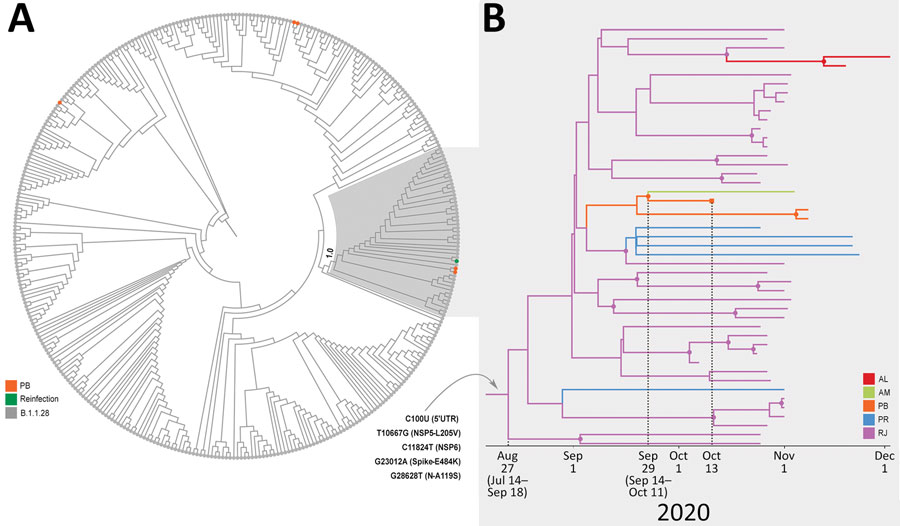Severe Acute Respiratory Syndrome Coronavirus 2 P.2 Lineage Associated with Reinfection Case, Brazil, June–October 2020
Paola Cristina Resende

, João Felipe Bezerra, Romero Henrique Teixeira Vasconcelos, Ighor Arantes, Luciana Appolinario, Ana Carolina Mendonça, Anna Carolina Paixao, Ana Carolina Duarte, Thauane Silva, Alice Sampaio Rocha, Ana Beatriz Machado Lima, Alex Pauvolid-Corrêa, Fernando Couto Motta, Dalane Loudal Florentino Teixeira, Thiago Franco de Oliveira Carneiro, Francisco Paulo Freire Neto, Isabel Diniz Herbster, Anderson Brandao Leite, Irina Nastassja Riediger, Maria do Carmo Debur, Felipe Gomes Naveca, Walquiria Almeida, Mirian Livorati, Gonzalo Bello
1, and Marilda M. Siqueira
1
Author affiliations: Instituto Oswaldo Cruz, Rio de Janeiro, Brazil (P.C. Resende, I. Arantes, L. Appolinario, A.C. Mendonça, A.C. Paixao, A.C. Duarte, T. Silva, A.S. Rocha, A.B.M. Lima, A. Pauvolid-Corrêa, F.C. Motta, G. Bello, M.M. Siqueira); Universidade Federal da Paraíba, João Pessoa, Brazil (J.F. Bezerra, R.H.T. Vasconcelos); Texas A&M University, College Station, Texas, USA (A. Pauvolid-Corrêa); Laboratório Central do Estado da Paraíba, João Pessoa (L.F. Teixeira, T.F. de Oliveira Carneiro); Universidade Federal do Rio Grande do Norte, Natal, Brazil (F.P.F. Neto); Maternidade Escola Januario Cicco, Natal (I.D. Herbster); Laboratório Central do Estado do Alagoas, Maceió, Brazil (A.B. Leite); Laboratório Central do Estado do Paraná, Curitiba, Brazil (I.N. Riediger, M.C. Debur); Instituto Leônidas e Maria Deane, on behalf of the COVIDNORTE team, Manaus, Brazil (F.G. Naveca); Ministério da Saúde do Brasil, Brasilia, Brazil (W. Almeida, M. Livorati)
Main Article
Figure 2

Figure 2. Emergence of the P.2 clade in study of severe acute respiratory syndrome coronavirus 2 (SARS-CoV-2) reinfection case, Brazil. A) Maximum-likelihood phylogenetic tree of B.1.1.28 SARS-CoV-2 whole-genome sequences (29,779-nt) from Brazil (n = 376). Shaded box highlights the P.2 clade (n = 47), and its statistical support (approximate-likelihood ratio test = 1.0) is indicated in the cladogram. Sequences from Paraíba are indicated in orange and sequences from the reinfection case are indicated by green. B) Time-scaled Bayesian maximum clade credibility tree of SARS-CoV-2 whole-genome sequences from the P.2 clade (n = 47). Branches are colored according to the most probable location state of their descendent nodes as indicated. The 5 lineage-defining single-nucleotide polymorphisms are indicated at the maximum clade credibility tree root node. Circular shapes mark nodes with high statistical support (posterior probability>9.0), and a square tip shape indicates the sequence from reinfection case. AL, Alagoas; AM, Amazonas; PB, Paraíba; PR, Parana; RJ, Rio de Janeiro; UTR, untranslated region.
Main Article
Page created: April 12, 2021
Page updated: June 16, 2021
Page reviewed: June 16, 2021
The conclusions, findings, and opinions expressed by authors contributing to this journal do not necessarily reflect the official position of the U.S. Department of Health and Human Services, the Public Health Service, the Centers for Disease Control and Prevention, or the authors' affiliated institutions. Use of trade names is for identification only and does not imply endorsement by any of the groups named above.
